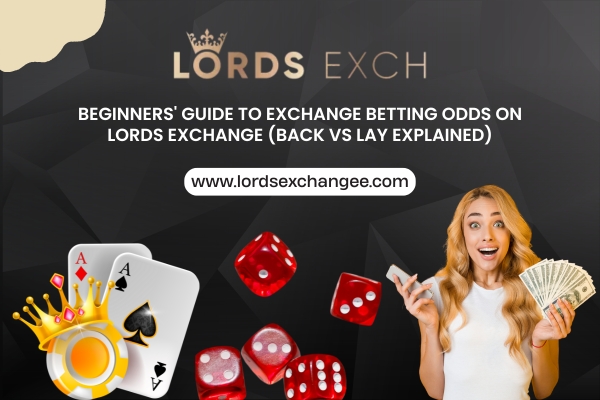Beginners’ Guide to Exchange Betting Odds on Lords Exchange (Back vs Lay Explained)
If you’ve just started betting on Lords Exchange, you already know the basics — pick a team, place a bet, hope it wins. But that’s only half of what this platform was built for. Lords Exchange is not a regular bookmaker where you can only bet on something to happen. It’s a full exchange betting system, which means you can also bet against an outcome — just like a bookmaker does.
That’s where the real power (and profit potential) starts.
This guide is written for beginners who want to understand how odds work, what Back and Lay mean, how profit and liability are calculated, and how to stop betting blindly and start betting strategically.
By the end of this article, you’ll understand how to read odds, how to trade them, and how experienced bettors make money even when they don’t know who will win.
Let’s begin.
What Is Exchange Betting?
On most betting apps, you only have one option:
Bet for something to happen (Team A wins, Player scores, Over 150 runs, etc.)
That’s called bookmaker-style betting — you bet against the company.
But Lords Exchange is different. It’s a peer-to-peer betting exchange, meaning:
✅ You don’t bet against the platform
✅ You bet against other users
✅ The odds are created by the market, not a sportsbook
✅ You can choose to be a bettor (Back) or a bookmaker (Lay)
This gives users more control, better odds, and a chance to trade the market instead of just predicting outcomes.
What Does “Back” Mean?
A Back bet is the traditional bet — you want something to happen.
Examples:
- Back India to win the match
- Back over 6.5 goals
- Back Virat Kohli to score 50+ runs
If your prediction is correct, you win. If not, you lose your stake.
✅ Back Bet Profit Formula
Profit = (Stake × Odds) – Stake
Example:
- Odds: 2.50
- Stake: ₹1,000
- If you win → (1000 × 2.50) – 1000 = ₹1,500 profit
Simple, right?
That’s why beginners start with Back bets — easy to understand, low risk, fixed stake.
What Does “Lay” Mean?
A Lay bet is the opposite of Back.
Instead of betting for, you’re betting against an outcome.
Examples:
- Lay India to win (you profit if India loses or draws)
- Lay a batsman to score 50 (you profit if he scores less)
- Lay Team A at odds 3.0 (you profit if they don’t win)
When you Lay, you act like the bookmaker.
You’re offering odds to others, and you profit if they are wrong.
But here’s the part beginners must understand:
✅ In a Lay bet, your potential loss is not just your stake — it’s called liability.
✅ Liability = how much you must pay if the other user wins.
Back vs Lay – Simple Comparison
| Feature | Back Bet | Lay Bet |
| You are betting | FOR an outcome | AGAINST an outcome |
| You profit when | Outcome happens | Outcome does NOT happen |
| Max loss | Your stake | Your liability |
| Easy for beginners? | Yes | Requires understanding risk |
| Who you’re against | Another bettor | Anyone backing the outcome |
Example Breakdown (Cricket Match)
📌 Back Bet Example
You Back India to win at odds 2.00
Stake = ₹1,000
- If India wins → You win ₹1,000 profit
- If India loses → You lose ₹1,000 stake
📌 Lay Bet Example
You Lay India to win at odds 2.00
Stake (user you’re betting against) = ₹1,000
Your liability = ₹1,000
- If India loses → You win the ₹1,000 stake
- If India wins → You lose your ₹1,000 liability
So both bets are on the same market, but their logic is opposite.
Why Professionals Use Lay Bets
Because they don’t need to predict the winner — they only need to predict what won’t happen.
✅ You can profit if the match ends in a draw
✅ You can profit if the favorite underperforms
✅ You can hedge existing Back bets to lock profit early
✅ You can trade odds like stock prices without caring about final result
That’s why Lay betting is called smart betting — you trade probabilities, not just outcomes.
Understanding Liability – The Most Important Beginner Rule
When you Back, you risk only your stake.
When you Lay, you risk more than your stake.
That extra risk is called liability.
✅ Lay Liability Formula
Liability = (Stake × Odds) – Stake
Example:
- Odds: 3.00
- Backer’s stake: ₹1,000
- Your liability = (1000 × 3.00) – 1000 = ₹2,000
So if your Lay bet loses, you pay ₹2,000.
If your Lay bet wins, you take the other user’s ₹1,000.
That’s why beginners must start small when learning Lay bets.
How Odds Move and Why It Matters
Odds in an exchange are like market prices — they move based on:
- Momentum in the game
- Money entering market (liquidity)
- Risk perception (favorites vs underdogs)
- Live events (wicket, goal, timeout, injury, etc.)
This means you can:
✅ Buy low (Back early) and sell high (Lay later)
✅ Sell high (Lay first) and buy low (Back later)
✅ Lock profit without waiting for match result
This is called trading the odds, and it’s how serious bettors profit consistently.
Smart Beginner Tips Before You Start
✅ Don’t Lay without understanding liability
✅ Start with small stakes until you understand exposure
✅ Never enter a market with low liquidity (odds may not match)
✅ Use Cash Out or hedging instead of waiting for outcome
✅ Treat betting balance like trading capital, not gambling chips
Final Takeaway
There are two types of users on Lords Exchange:
1️⃣ The bettor – places a Back bet and waits
2️⃣ The trader – uses Back and Lay to profit before the match ends
If you only know how to Back, you’re playing half the game.
If you learn how to Lay, you unlock the real power of the exchange.
Once you understand Back vs Lay, you stop depending on “luck” and start depending on math, timing, and odds movement.
That’s how beginners become profitable.




